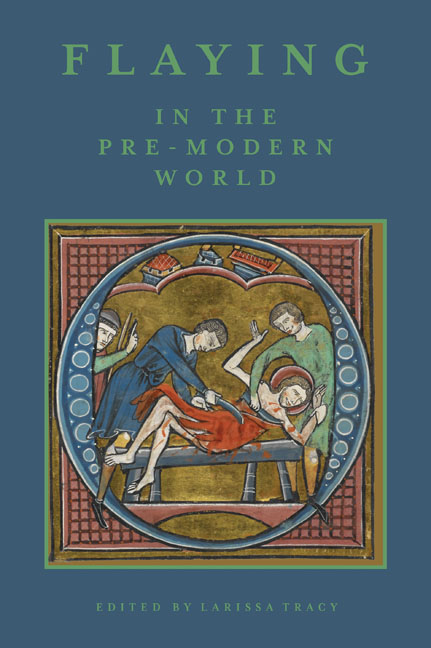Epilogue: Anthropodermic Bibliopegy in the Early Modern Period
Published online by Cambridge University Press: 21 May 2021
Summary
FLESH, as a signifier, is fluid. As the chapters in this volume demonstrate, both the act of flaying and the removed skin itself represent a vast range of signifiers, sometimes seemingly contradictory. When practised as a punishment, Larissa Tracy correctly asserts that flaying serves to ‘figuratively [excise] the crimes and the identity of the accused’. However, the significance of the flayed skin does not end at the removal of identity; the dehumanizing act also provides the opportunity for transformation. For the monsters depicted in medieval Icelandic sagas, the removal of skin ‘enables them to act in support of, rather than in opposition to, the heroes in each saga’, allowing them fluidly to shift their roles in the romances away from the monstrous. Yet, the victim of the flaying was not always the only one to undergo change. As Frederika Bain observes, for both the reallife Aztecs and the characters in literary works such as Salman und Morolf, the wearing of flayed skin is a way to undergo a personal metamorphosis, and ‘skin-wearing is assumed to facilitate passage to an alternative state of being’. Flaying has grave consequences for flayed and flayer alike, as Michael Livingston and Emily Leverett explain. Finally, as several contributions to this volume suggest, the representation of Christ and St Bartholomew's flayed skins in art and literature provide audiences with means to witness and better understand both the human and the divine. Skin is also the substance of texts themselves – cured, scraped, stretched – it is the surface upon which these narratives, and all their incumbent meanings, are inscribed.
The variety of meanings this sign takes on is exemplified in the process of anthropodermic bibliopegy – the act of binding books in human skin. Like the flayed skin that makes up their binding, the owners of the books used them in a plethora of ways – to construct their own social and religious identity, to strike out against and dehumanize those with competing ideologies and to situate themselves within a larger social tradition. Yet, despite its variety of uses and prevalence as a plot device in modern works of horror fiction, anthropodermic bibliopegy was a historically rare occurrence. The rarity of the act notwithstanding, consistently recorded instances of its practice range from the Middle Ages until the present day, with purported examples residing in public and private libraries in both Europe and the United States.
- Type
- Chapter
- Information
- Flaying in the Pre-Modern WorldPractice and Representation, pp. 366 - 383Publisher: Boydell & BrewerPrint publication year: 2017
- 1
- Cited by

